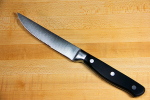Fixall
Brian
- Joined
- Mar 26, 2018
- Messages
- 5,401
Well that actually went ok.  It was my first time using a belt sander to shape wood, so there was a bit of a learning curve. The Harbor Freight 1" x 30" certainly doesn't perform like the 2" x 72" I was using on steel at Bob's, lol. I got overconfident a few times, but no huge errors. I didn't want to spend a ton of time shaping what is just a rough prototype, but I'll be sure to really take my time on the G10 pattern/template. I was going to contour all five handle prototypes, but I don't think that is necessary anymore. After softening the edges of the five contenders, it was obvious that two of them weren't going to work at all.
It was my first time using a belt sander to shape wood, so there was a bit of a learning curve. The Harbor Freight 1" x 30" certainly doesn't perform like the 2" x 72" I was using on steel at Bob's, lol. I got overconfident a few times, but no huge errors. I didn't want to spend a ton of time shaping what is just a rough prototype, but I'll be sure to really take my time on the G10 pattern/template. I was going to contour all five handle prototypes, but I don't think that is necessary anymore. After softening the edges of the five contenders, it was obvious that two of them weren't going to work at all.
Also, is there any better feeling than getting a temperamental band saw to track absolutely dead straight?!
If I have time tomorrow, I'll add contours to the top three and thin out the handles where they'd meet the blade and see how they feel.
The one up top felt the best to me. The second down felt the best to my wife. The one in the middle was the runner-up for both of us. The fourth and fifth down both felt lame and are out of the running.
Right now I'm kind of leaning towards the second from the top, just because it's the only one that I came up with without looking at pictures on the internet.

I've got go back to the drawing board when it comes to handle material. I thought I had enough stabilized walnut burl for six knives, but it looks like I only have enough for four. I also decided not to use the stabilized curly walnut for these either.
So that leaves either cocobolo, african blackwood, or desert ironwood. I'm a little hesitant to use unstabilized wood for kitchen knives, but these should all be plenty durable.
Also, is there any better feeling than getting a temperamental band saw to track absolutely dead straight?!
If I have time tomorrow, I'll add contours to the top three and thin out the handles where they'd meet the blade and see how they feel.
The one up top felt the best to me. The second down felt the best to my wife. The one in the middle was the runner-up for both of us. The fourth and fifth down both felt lame and are out of the running.
Right now I'm kind of leaning towards the second from the top, just because it's the only one that I came up with without looking at pictures on the internet.

I've got go back to the drawing board when it comes to handle material. I thought I had enough stabilized walnut burl for six knives, but it looks like I only have enough for four. I also decided not to use the stabilized curly walnut for these either.
So that leaves either cocobolo, african blackwood, or desert ironwood. I'm a little hesitant to use unstabilized wood for kitchen knives, but these should all be plenty durable.
Last edited:








